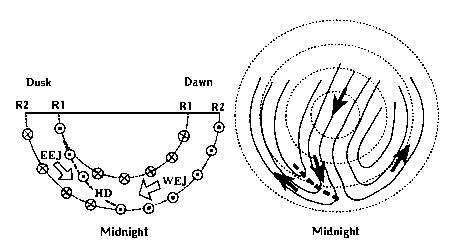 Harang discontinuity
Harang discontinuity Harang discontinuity
Harang discontinuityThe Harang discontinuity (HD) is a region of sharp reversal of the evening sector (around 2200-2400 MLT) ionospheric convection electric field from the poleward field on the equatorward side of the auroral oval to an equatorward field on the poleward side of the oval. In terms of auroral electrojets the discontinuity corresponds to the shear zone where the eastward electrojet (EEJ), equtorward of the shear, and the westward electrojet (WEJ), poleward of the shear, meet (Koskinen et al., 1993). Strangely enough, the location of the discontinuity is little different depending on the way it is measured: the direct "electric" discontinuity is 1-2° poleward of the "magnetic" (electrojets as observed from ground) one (Kamide and Vickrey, 1983; Kunkel et al., 1986).
 |
| Schematic picture of the Harang discontinuity (HD, dashed line). In the left panel the electrojets and large-scale FACs are shown, and in the right panel the arrows indicate the plasma flow directions. R1, R2 = Region 1 and 2 currents, EEJ, WEJ = eastward and westward electrojets (from Koskinen and Pulkkinen, 1995). |
The longitudinal position of the Harang discontinuity is controlled by IMF By component: increasing positive (negative) values displace it towards earlier (later) local times within the evening sector (Rodger et al., 1984). HD is a often a source of strong FAC collocated with the nightside region 1 current system (Kunkel et al., 1986), which may be a result of a dawn-dusk pressure gradient in the central plasma sheet (Erickson et al., 1991).
The role of the Harang discontinuity in substorms is not yet properly established (Koskinen and Pulkkinen, 1995). Many events have shown how the the substorm onset arc is located just equatorward of the "electric" HD. It should also have some relationship to ionospheric trough.
See also: